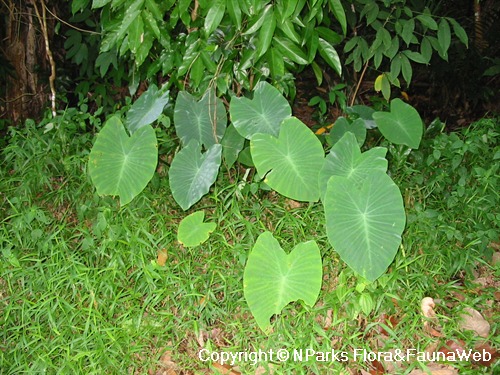.jpg)
Back
Colocasia esculenta (L.) Schott
| Family Name: | Araceae |
| Synonyms: | Alocasia dussii, Alocasia illustris, Arum chinense |
| Common Name: | Taro, Yam, Cocoyam, Dasheen, Ubi Keladi, Eddoe, Elephant's Ear, Keladi, 芋, 芋头 |
Colocasia esculenta or Taro is the oldest cultivated species in the Aroid family. This edible herb reaches up to 2 m tall, produces heart shaped to arrow shaped leaves that droop downwards. The swollen stem, often called tubers are pounded into a thick paste to make a wide variety of food including the popular local dessert, Orh-Nee.
Name
Classifications and Characteristics
| Plant Division | Angiosperms (Flowering Seed Plants) (Monocotyledon) |
|---|---|
| Plant Growth Form | Herbaceous Plant |
| Lifespan (in Singapore) | Perennial |
| Mode of Nutrition | Autotrophic |
| Plant Shape | Compact |
| Maximum Height | 1 m to 1.5 m |
Biogeography
| Native Distribution | Tropical Southeastern Asia, China, Japan, West Indies |
|---|---|
| Native Habitat | Terrestrial |
| Preferred Climate Zone | Tropical |
| Local Conservation Status | Non-native (Spontaneous (Casual)) |
Description and Ethnobotany
| Growth Form | It is a large evergreen herb that grows up to 1 – 2 m tall. |
|---|---|
| Foliage | Its leaves are large, smooth, heart-shaped to arrow-shaped, drooping downwards. The thick fleshy petiole is green, sometimes purple. It is attached near the centre of the leaf (peltate), measuring 25 – 80 cm long. |
| Stems | It produces a short thick tuber that is round, elongated or cylindrical of up to 35 cm long and 15 cm wide. The skin of the tuber appears rough, fibrous with presence of ring-like scars. |
| Flowers | Its flowers are borne on a spadix inflorescence. The inflorescence occur in solitary or up to clusters of 3. The spathe is longer than the spadix, cream to golden yellow in colour, measures between 13 – 24 cm long. |
| Fruit | Its fruits are berry-like, yellow-brown when ripe. |
| Habitat | Often found naturalised or native to moist forest, next to small streams, riverbanks or marshes. It can also be found along roadside ditches and disturbed areas. |
| Similar | This species is similar to Alocasia macrorrhizos. The key differences are the leaf stalk (petiole) of Colocasia esculenta is attached near the centre of the leaf and the leaf droops downwards. Unlike the Alocasia macrorrhizos, the petiole is attached near the edge while the leaf stays upright. |
| Cultivation | It is adaptable to most soil types including flooded conditions (up to 0.4m deep). Therefore, it is hard to overwater this plant. However, it does best in deep, loose and well-drained soil, rich in organic matter. |
| Etymology | The specific epithet, esculenta means edible or good to eat |
| Ethnobotanical Uses | Edible Plant Parts : Edible Leaves, Edible Storage Organs Food (Fruit or Vegetable): This species has been cultivated for 6,000 years as a food source. All parts of the taro plant are used in many cuisines. However, they should not be eaten raw, because they contain toxic calcium oxalate which is destroyed during the cooking process. The tubers are often pounded into a thick paste to make a wide variety of food including Singapore’s popular local desert, Orh-Nee. Poi, is a Hawaiian and Polynesian dish that is made by cooking, pounding and fermenting grated taro and coconut. The leaves and petioles are cooked as vegetables in China, Malaysia, Myanmar and Nepal. Others: This species has phytoremediation potential, because it accumulates mercury. |
Landscaping Features
| Desirable Plant Features | Ornamental Foliage |
|---|---|
| Landscape Uses | Interiorscape/ Indoor Plant, Pond / Lake / River, Marsh / Bog, Phytoremediation (Ground / Water Contaminant(s)) |
| Thematic Landscaping | Water Garden, Marsh Garden |
Plant Care and Propagation
| Light Preference | Full Sun, Semi-Shade |
|---|---|
| Water Preference | Lots of Water, Moderate Water |
| Plant Growth Rate | Fast |
| Rootzone Tolerance | Easy to Grow, Moist Soils, Well-Drained Soils, Waterlogged Soils |
| Propagation Method | Division |
Foliar
| Foliage Retention | Evergreen |
|---|---|
| Mature Foliage Colour(s) | Green |
| Mature Foliage Texture(s) | Velvety / Furry / Tomentose |
| Foliar Type | Simple / Unifoliate |
| Foliar Attachment to Stem | Petiolate |
| Foliar Shape(s) | Non-Palm Foliage (Cordate) |
| Foliar Venation | Pinnate / Net |
| Foliar Margin | Entire - Wavy / Undulate |
| Foliar Apex - Tip | Acute |
| Foliar Base | Cordate |
| Typical Foliar Area | Macrophyll ( 182.25cm2 - 1640.25 cm2 ) |
| Leaf Area Index (LAI) for Green Plot Ratio | 3.5 (Shrub & Groundcover - Monocot) |
Floral (Angiosperm)
| Flower & Plant Sexuality | Unisexual Flowers |
| Flower Colour(s) | Yellow / Golden |
|---|---|
| Flower Texture(s) | Smooth |
| Flower Grouping | Cluster / Inflorescence |
| Inflorescence Type | Spathe & Spadix |
References
| References | Yong J, Tan PY, Nor Hafiz Hassan, Tan SN. 2010. A Selection of Plants for Greening of Waterways and Waterbodies in the Tropics. Singapore: Chung Printing . 480 pp. |
|---|
Image Repository
Others
| Master ID | 539 |
|---|---|
| Species ID | 1835 |
| Flora Disclaimer | The information in this website has been compiled from reliable sources, such as reference works on medicinal plants. It is not a substitute for medical advice or treatment and NParks does not purport to provide any medical advice. Readers should always consult his/her physician before using or consuming a plant for medicinal purposes. |


.jpg)
.jpg)
.jpg)
.jpg)


.jpg)
.jpg)